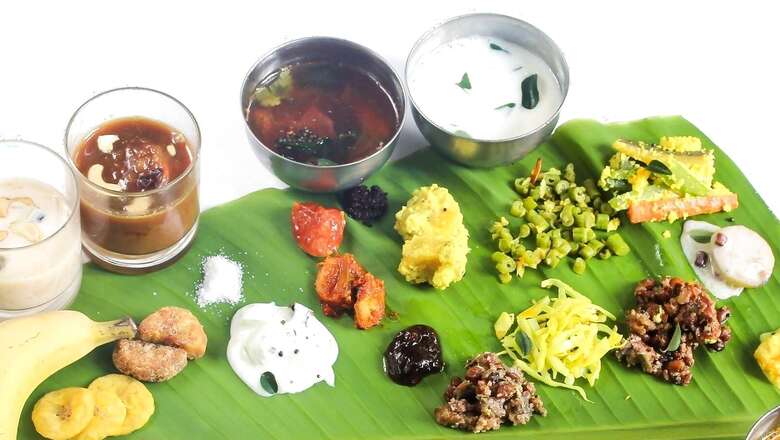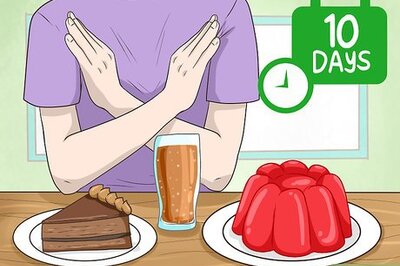
views
For those of you’ll who may not be aware, Onam is essentially a rice harvest festival, like many other harvest festivals celebrated across the country around the same time. But Onam also draws significance through mythological tales like the one about Mahabali and Vamana and also another about the great Brahmin warrior Parshuram. But to me, the greatness of this festival is that it is probably the only festival in the country that cuts across all religions in the state — Hindus, Muslims and Christians — and is celebrated by all segments of society with equal zeal. And it is at this festival that the Malayalees produce this most deliciously complex, heterogenous meal called the Sadya or Onasadya.
Onasadya is the main attraction of Onam. It is a traditional feast that is prepared with vegetables, grain and crop that is supposed to have been harvested during the season. Usually served for lunch on a large banana leaf, the sadya meal can be as simple as eleven dishes and could go up to 26 dishes (as it usually does on Onam), or could go up to sixty-four, or even more. The famous Aranmula Vallasadhya goes as far as a 100 or more different foods in one meal. Every year a flotilla of 52 boats from neighbouring hamlets proceed in an overnight journey to the Aranmula Parthasarathy Temple in South Kerala. What follows is one of the largest vegetarian feasts in India, which features between close to a hundred dishes and feeds over a thousand people.
But let us restrict ourselves to a normal Onam Sadya. If you really want to enjoy a twenty-six course meal and yet remain standing, the meal needs to be perfectly balanced. A balance of acid, proteins, carbohydrates and fat is the only way you can consume a Sadhya and live to tell the story. And the science starts with the banana leaf itself. Rich in antioxidants, and polyphenols, serving food on a banana leaf helps digestion and protects you from any impurities. Once the banana leaf is laid out in front of you, the meal can begin.
The banana leaf is always placed with the tapering end to the left and the wider end to the right. That is because most of us eat with our right hand. So you serve rice and curries on the wider right side of the leaf making it easier to eat the large portions of rice and curry. The pickles and chutneys which are always served obviously in smaller quantities are placed on the left of the leaf. All Sadyas will comprise Avial (curd curry), Thoran (dry vegetables), pickles, lemon, salt, boiled rice and Payasam (a sweet dish).
The meal starts with Kaya Varuthathu (crisp banana chips fried in coconut oil), Sarkara Varatti (jaggery-coated banana chips), at least two kinds of pickle, Nurukku Manga Achar (mango picke) or Naranga Achar (Spicy Lemon Pickle with Sesame Oil) or both.
Along with that is served a Pachadi (a sour curd curry made with cucumber and ash gourd cooked in coconut, mustard seeds and curry leaves). Then comes the classic Avial, the nectar of Kerala — soft and creamy vegetables cooked with coconut, curd, coconut oil and curry leaves. The ubiquitous Sambar and a pepper-spiked Rasam. Then there is Parippu (a thick moong dal curry cooked with grated coconut and seasoned with spices and drizzled with ghee).
Thoran can be made from any vegetables that are fresh and available — carrots, cabbage, beans, tomatoes or leafy veggies, and these quickly cooked vegetables are flavoured with coconut and green chillies. You can get indulgent and add dishes such as Erissery (a coconut curry of pumpkin and black-eyed peas), Kaalan (a sour dish made with bananas or yam cooked in yogurt, and coconut) and Olan (spiced black peas in coconut milk). The grand finale is Palada Pradhaman (a sweet dish made with rice, milk and dry fruit) or Pazham Pradhaman (rice with coconut pieces and jaggery) usually the last dish served. Tradition dictates that after desert you end the meal with sour lemon pickle, to prevent any sluggishness that might occur after such an elaborate meal.
Sadya is not only served during Onam, a Sadya can also be any traditional meal served during a wedding or at any other celebrations. And regardless of your caste, community or religion, the Sadya lives in the hearts of the entire Kerala. That is why you shouldn’t be surprised if you came across regional variants of the Sadya such as a seafood Sadya in coastal Kerala or a Sadya abounding with meat and poultry from central and north Kerala. This not only makes the Sadya one of India’s most delicious meals, but also the most inclusive.
Kunal Vijayakar is a food writer based in Mumbai. He tweets @kunalvijayakar and can be followed on Instagram @kunalvijayakar. His YouTube channel is called Khaane Mein Kya Hai. The views expressed in this article are those of the author and do not represent the stand of this publication.
Read all the Latest News, Breaking News and Assembly Elections Live Updates here.




















Comments
0 comment